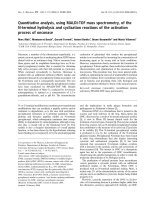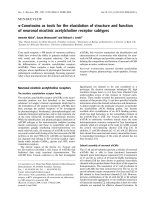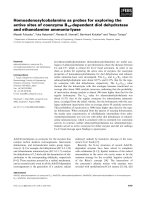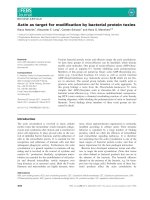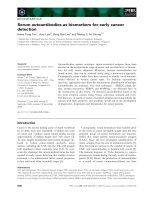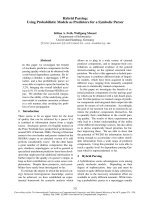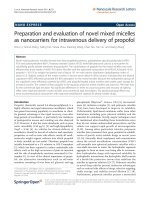metal-organic framworks irmof-8, zif-9, mof-199 and irmof-3 as catalysts for friedel-crafts acylation, knoevenagel, azamichel and pall-knorr reactions
Bạn đang xem bản rút gọn của tài liệu. Xem và tải ngay bản đầy đủ của tài liệu tại đây (230.98 KB, 19 trang )
VIETNAM NATIONAL UNIVERSITY - HO CHI MINH CITY
HO CHI MINH CITY UNIVERSITY OF TECHNOLOGY
NGUYEN THI LE LIEN
METAL-ORGANIC FRAMEWORKS IRMOF-8, ZIF-9, MOF-199 AND
IRMOF-3 AS CATALYSTS FOR THE FRIEDEL–CRAFTS
ACYLATION, KNOEVENAGEL, AZA-MICHAEL AND PAAL-KNORR
REACTIONS
Major: Organic chemical Technology
Major code: 62527505
PhD THESIS SUMMARY
HO CHI MINH CITY 2013
The dissertation was completed in Ho Chi Minh city University of Technology -
Vietnam National University – Ho Chi Minh city
Supervisor : Assoc Professor Phan Thanh Sơn Nam
Independent opponent 1:
Independent opponent 2:
Oppenent 1:
Opponent 2:
Opponent 3:
The dissertation will be defended before thesis committee at
………………….
………………….
On ………….
The thesis information can be looked at following libraries:
- General Science Library – Ho Chi Minh city
- Library of Ho Chi Minh University of Technology– VNU-HCMC
1
INTRODUCTION
MOFs are extended porous structures composed of transition metal ions or
clusters that are linked by organic bridges. Compared to conventionally used
microporous and mesoporous inorganic materials, these metal-organic structures have
the potential for more flexible rational design, through control of the architecture and
functionalization of the pores.
Employing MOFs as catalysts is a young research area, as compared with the
field of gas capture and storage. Indeed, MOFs have emerged as a hot topic in
heterogeneous catalysis. Similarly to zeolites, the large surface area and open porosity
of MOFs allows the access of substrates to the active sites present inside the crystal
structure. One of the advantages of MOFs compared to zeolites is the large diversity
of transition metals and organic linkers that can be used for the synthesis of MOFs.
The necessity of the study
With the increasing emphasis on green chemistry, environmentally benign
processes should be developed to improve the green credentials of the reaction. For
the development of greener processes, moisture-insensitive and easy handling solid
acid catalysts are desired. Furthermore, the use of solid acid catalysts offers easy
catalyst recovery and recycling, as well as product separation. At the same time, the
catalyst recovery also decreases contamination of the desired products with hazardous
or harmful metals.
The utilization of highly porous MOFs as efficient heterogeneous catalysts for
liquid organic reactions should be examined and investigated.
2
CHAPTER 1. LITERATURE REVIEWS
1.1 Metal organic framework
The MOFs consists of organic ligand and metal active site with extremely high
porosity. One of the outstanding properties of porous materials in the comparison with
other material is their high surface areas. Which can be obtained from 1000 to
8000m
2
/g. MOFs are stable with the temperature that ranges from about 400
o
C to 500
o
C.
Their application is mostly in gas storage, separation and catalysis. MOFs also
exhibit the physical properties usually encountered in dense inorganic solids:
fluorescence, magnetic susceptibility, conductivity, optical properties.
Zeolitic imidazolate frameworks (ZIFs) are a new class of porous materials that
potentially have the advantages of both inorganic zeolites (for example, high stability)
and MOFs (for example, high porosity and organic functionality).
MOFs are synthesized by mixing organic ligands and metal salts under
solvothermal reaction conditions at relatively low temperatures (typically, below
300°C). MOFs are also synthesized by diffusion method, and gel methods.
1.2 The application of MOFs in catalysis
In all MOF compounds, three different parts can be clearly differentiated: (i) the
metallic component, (ii) the organic ligand, and (iii) the pore system. Potential
catalytic activity of MOFs can be envisaged from a direct inspection of their structure,
like those containing, e.g., redox active centers in a given coordination environment,
organic groups with basic properties (such as amides or amines), or metal sites with
potential coordinative unsaturations, which could behave as active centers for certain
Lewis catalyzed processes. MOFs can be of interest since they allow high density of
catalytic sites, in particular when these active sites are transition metals.
In the field of catalysis, several MOFs have been used as solid catalysts or catalyst
supports for a variety of organic transformations such as Knoevenagel condensation,
aldol condensation, oxidation, epoxidation, hydrogenation, Suzuki cross-coupling,
transesterification reaction, Friedel-Crafts alkylation, epoxide ring-opening reaction,
methylation of aromatic amines, activation of alkynes, domino coupling and
cyclization reactions, and alkene cyclopropanation. As in the case of zeolites, the
application of MOFs in catalysis is undoubtedly an area that will attract further
research in the near future.
3
1.3 Aim and objectives of the study
The Friedel Craft acylation reaction
Friedel–Crafts acylation reactions of aromatic compounds with acid chlorides are
considered as fundamental and important processes in organic synthesis as well as in
industrial chemistry. Traditionally, these reaction require the presence of more than
stoichiometric amounts of anhydrous strong Lewis acids such as AlCl
3
, TiCl
3
, FeCl
3
,
or SnCl. These methods suffer from high amounts, toxicity and corrosion of the
catalysts, generation of a large amount of waste, and difficult purification of products.
Moreover, these catalysts are highly moisture sensitive and hence moisture-free
reaction conditions are required to achieve the optimal yields of the desired aromatic
ketones. Several solid acid catalysts have been investigated for the Friedel-Crafts
acylation reactions, such as metal triflate loaded SBA-15, mesoporous superacid
catalyst, zeolit, hybrid zeolitic-mesostructured materials, modified clay, nafion/silica
composite materials, mesoporous sulphated zirconi, and mesoporous sieve AlKIT-5.
Although interesting results have been achieved for the Friedel-Crafts acylation
reaction, they have not led to any very important industrial application.
The Knovenagel reaction
The Knoevenagel reaction of aldehydes with compounds containing activated
methylene groups has been widely employed in the synthesis of several fine chemicals
as well as heterocyclic compounds of biological significance. This reaction is
conventionally catalyzed by alkali metal hydroxides or by organic bases like primary,
secondary and tertiary amines under homogeneous conditions with the attendant
difficulties in catalyst recovery and recycling. Over the last few years, a wide range of
solid catalysts have been investigated for this reaction such as amino-functionalized
mesoporous silica, diamine-functionalized mesopolymers, amine-functionalized
mesoporous zirconia, superparamagnetic mesoporous Mg–Fe bi-metal oxides,
mesoporous titanosilicate, basic MCM-41 silica, acid-base bifunctional mesoporous
MCM-41 silica, nanocrytalline ceria–zirconia, zeolites exchanged with
alkylammonium cations, amine-functionalized superparamagnetic nanoparticles,
chitosan hydrogel, acrylic resin immobilized lipase, organic-inorganic hybrid silica
materials containing imidazolium and dihydroimidazolium salts, IRMOF-3, and ZIF-8
The Aza-Michael reaction
The aza-Michael reaction of amines and -unsaturated carbonyl
compounds has attracted significant attention as one of the most effective methods to
prepare -amino carbonyl compounds and their derivatives. These structures serve as
essential intermediates in the synthesis of a variety of biologically important natural
4
products, antibiotics, peptide analogues, chiral auxiliaries, and other nitrogen-
containing compounds. Traditionally, stoichiometric or catalytic amounts of several
Lewis acids have been employed for the process, including AlCl
3
, HgCl
2
, TiCl
4
,
Bi(NO)
3
, CeCl
3
.7H
2
O-NaI, FeCl
3
.6H
2
O, LiClO
4
, Na
2
SnO
3
Ni(ClO
4
)
2
.6H
2
O,
Cu(OTf)
2
, and boric acid. Employing these Lewis acids required aqueous workup for
the catalyst separation, generating of a large amount of waste, and also suffering from
difficult product purification. Several solid catalysts have been investigated for the
aza-Michael reaction, including glutathione supported on magnetic nanoparticles,
graphene oxide, modified IRMOF-3, Amberlyst-15, Co(II) complex supported on
mesoporous SBA-15, AlSBA-15, nanocrystalline copper(II) oxide, copper
nanoparticles, polyaniline supported CuI, azaphosphatrane nitrate salt immobilized on
Merrifield resin, Cu-Al hydrotalcite, silica gel, KF/Al
2
O
3
, and ZrOCl
2
.8H
2
O
immobilized on montmorillonite K10. Although interesting results have been achieved
for the aza-Michael reaction, the development of simple and environmentally benign
approaches for the reaction is still the target of further research in the near future.
The Paal Knorr reaction
The Paal-Knorr condensation of primary amines with 1,4-dicarbonyl precursors has
been widely employed in the synthesis of pyrrole, pyrazoles, and their derivatives as
important intermediates for pharmaceutical and fine chemical industry, as well as for
the development of organic functional materials. Traditionally, the reaction could
effectively proceed in the presence of homogeneous Bronsted or Lewis acids such as
H
2
SO
4
, p-toluene sulfonic acid, Bi(NO
3
)
3
, Al
2
O
3
, FeCl
3
, CoCl
2
, Sc(OTf)
3
, ZrOCl
2
,
Yb(OTf)3, indium salts, titanium isopropoxide, and zinc tetrafluoroborate. Recently,
the Paal-Knorr condensation has been carried out in the presence of a variety of solid
catalysts, including layered zirconium phosphate and phosphonate, silica sulfuric acid,
zeolite, magnetic nanoparticle-supported glutathione, nano β-PbO, polystyrene-
supported aluminum chloride, macroporous strongly acidic styrol resin (D001), and
cationic exchange resin. Although promising results have been achieved, the
development of a more efficient catalyst for the reaction is still in great demand.
Objectives of this study:
- Synthesis of four different MOF materials: IRMOF-8, ZIF-9, MOF-199, IRMOF-3
- Characterization of the four MOF materials by modern analysis techniques
- Catalytic study of the four tested reactions, Friedel -Craft acylation, Knoevenagel
reaction, aza-Michael reaction and Paal-Knorr reaction, by IRMOF-8, ZIF-9,
MOF-199, IRMOF-3, respectively.
5
CHAPTER 2. EXPERIMENTAL
2.1 Synthesis of MOF catalysts
Four types of MOFs- IRMOF-8, ZIF-9, MOF-199, and IRMOF-3 have been
synthesized by solvothermal methods.
- Pale-yellow cubic-shaped crystals (71% based on 2,6-napthalenedicarboxylic acid)
was collected as IRMOF-8.
- Purple cubic crystals (25% based on benzimidazole) was collected as ZIF-9.
- Deep purple crystals (88% based on 1,3,5-benzenetricarboxylic acid) was collected
as MOF-199
- Pale yellow crystals (68% based on 2-amino-1,4-benzenedicarboxylic acid) was
collected as the synthesized IRMOF-3.
The synthezed MOFs were characterized by modern analysis technologies such as
XRD, SEM, TEM, TGA, nitrogen adsorption/desorption isotherm, FT-IR, and
AAS
2.2 Application of MOF in catalysis
The IRMOF-8 was assessed for its activity as a solid acid catalyst in the Friedel-
Crafts acylation of toluene with benzoyl chloride to form p-benzoyltoluene as the
major product and o-benzoyltoluene as the minor one.
The ZIF-9 catalyst was assessed for its activity in the Knoevenagel reaction by
studying the condensation of benzaldehyde with malononitrile to form benzylidene
malononitrile as the principal product.
The reaction aza-Michael reaction of benzylamine with ethyl acrylate to form
ethyl 2-(benzylamino)acetate (A) as the principal product was catalyzed by MOF-199.
The Paal-Knorr reaction of benzyl amine with 2,5-hexanedione using the
IRMOF-3 catalyst was carried out to define its catalytic efficiency.
All reactions were carried out in a magnetically stirred round-bottom flask at
various conditions. Samples were taken every one hour. Reaction conversions were
analyzed by GC system.
6
CHAPTER 3. RESULT & DISCUSSION
3.1 Catalyst characterization
The four MOFs were characterized by XRD, SEM, TEM to confirm their
crystalline and porous structure. Surface areas are determined by nitrogen
adsorption/desorption isotherm as followed:
Catalyst
Surface area, m
2
/g
IRMOF-8
2110
ZIF-9
1144
MOF-199
1970
IRMOF-3
3295
The high surface areas and porous structure make the four synthesized MOFs
attractive candidate for application in catalysis.
Thermal stability of MOFs was defined by TGA analysis, and the results shown
that the MOFs were stable from 300 to 500
0
C.
Metal loading are determined by AAS techniques, given results as followed:
Zn loading in IRMOF-8 is 4.38 mmol/g
Co loading in ZIF-9 is 4.17 mmol/g
Cu loading in MOF-199 is 4.61 mmol/g
Zn loading in IRMOF-3 is 4.3 mmol/g
FT-IR spectra of the IRMOF-8 exhibited a significant difference as compared to
that of their corresponding ligands. The significant features observed were to confirm
the deprotonation in the carboxylate group when linked with the metal sites during the
formation of MOF structures
3.2 Catalytic studies
3.2.1 Friedel-crafts acylation reaction
CH
3
+
COCl
CH
3
+
CH
3
p-isomer
o-isomer
O
O
IRMOF-8
7
Scheme 3.1. Friedel-Craft acylation of toluence with benzoyl chloride using IRMOF-8
catalyst
Initial studies addressed the effect of temperature on the reaction conversion,
having carried out the reaction using 5 mol% IRMOF-8 catalyst and benzoyl
chloride:toluene molar ratio of 5 : 1 at 80
o
C, 90
o
C, and 100
o
C, respectively. It was
found that increasing the reaction temperature from 80
o
C to 90
o
C led to a significant
enhancement in reaction rate.
It was found in this research that the Friedel-Crafts acylation reaction of toluene
with benzoyl chloride using the IRMOF-8 catalyst could occur under solventless
condition, and that the reagent molar ratio had a profound effect on the reaction
conversion. Interestingly, decreasing the benzoyl chloride: toluene molar ratio from 5
: 1 to 1.5 : 1 resulted in a significant enhancement in reaction rate,. From experimental
points of view, it should be noted that using a benzoyl chloride: toluene molar ratio of
less than 1.5 : 1 could cause difficulty in stirring the reaction mixture containing the
solid catalyst.
The effect of catalyst concentration on reaction conversion was investigated. The
catalyst concentration, with respect to the zinc content in the IRMOF-8, was studied in
the range of 1-5 mol% relative to toluene. It was found that the Friedel–Crafts
acylation of toluene and benzoyl chloride proceeded readily in the presence of a
catalytic amount of the IRMOF-8. Conversions of 95%, 90%, and 88% were achieved
after 6 h at the catalyst concentration of 5 mol%, 3 mol%, and 1 mol%, respectively.
Fig. 3.1. Leaching test
In order to determine if leaching was a problem for the Friedel-Crafts acylation
reaction using the IRMOF-8 catalyst, an experiment was performed to estimate the
contribution of leached active species to the total reaction conversion by performing a
0
20
40
60
80
100
0 1 2 3 4 5 6
Time (h)
Conversion (%)
5 mol% Leaching test
8
simple centrifugation during the course of the reaction to remove the solid catalyst.
Within experimental error, no further reaction was observed after the solid IRMOF-8
was removed, proving that there was no contribution from leached active species and
that conversion was only being possible in the presence of the solid IRMOF-8
catalyst.
The replacement of environmentally unacceptable homogeneous Lewis acids
with solid acids offers several advantages including easy catalyst recovery and
recycling. The IRMOF-8 catalyst was therefore investigated for recoverability and
reusability in the Friedel-Crafts acylation reaction over five successive runs. It was
found that the IRMOF-8 catalyst could be recovered and reused in further reactions
without a significant degradation in activity. Conversions of 95%, 95%, 96%, 90%,
and 82% were achieved after 6 h for the 1
st
, 2
nd
, 3
rd
, 4
th
, and 5
th
run, respectively.
The study was then extended to the Friedel-Crafts acylation reaction of benzoyl
chloride with several aromatic hydrocarbon having different substituents, including
anisole, toluene, p-xylene, and ethylbenzene, respectively. Reactions were carried out
at 100
o
C with 3 mol% catalyst loading and at the benzoyl chloride: aromatic
hydrocarbon molar ratio of 1.5 : 1. As expected, the anisole benzoylation using the
IRMOF-8 catalyst proceeded with a higher reaction rate than that of toluene.
0
20
40
60
80
100
0 1 2 3 4 5 6
Time (h)
Conversion (%)
1st run 2nd run
3 rd run 4th run
5th run
Fig. 3.2 Catalytic recycling studies
The effect of different acylation reagents on the Friedel-Crafts acylation reaction
of toluene was also studied, having carried out the reaction using benzoyl chloride, 4-
methoxybenzoyl chloride, and 4-chlorobenzoyl chloride, respectively.
3.2.2 Knoevenagel reaction
CHO
CN
CN
CN
CN
H
2
O
+ +
ZIF-9
room temperature
Scheme 3.2 Knoevenagel reaction of benzaldehyde with malononitrile using the ZIF-9 catalyst
9
The reagent ratio is normally an important factor that should be taken into
consideration in the case of the Knoevenagel condensation. The effect of the
benzaldehyde : malononitrile molar ratio on reaction conversions was therefore
investigated, having carried out the reaction at molar ratios of 1:1, 1: 2, 1: 3, and 1 : 4,
respectively. Experimental results showed that 99% conversion was obtained after 4 h
for the reaction using the reagent molar ratio of 1 : 3. The reaction at the reagent molar
ratio of 1: 4 occurred more readily. The malononitrile:benzaldehyde molar ratio to 1 :
2 resulted in a significant drop in the reaction rate. The reaction using one equivalent
of malononitrile proceeded slowly, with only 49% conversion being observed after 6
h.
The catalyst concentration, with respect to the cobalt content in the ZIF-9, was
then studied in the range of 1-8 mol% relative to benzaldehyde. It was found that
decreasing the catalyst concentration to 3 mol% led to a significant drop in the
reaction rate. The results indicated that the ZIF-9 catalyst was quite active in the
Knoevenagel reaction. Furthermore, it exhibited higher activity than some previously
reported Lewis acid catalysts, where longer reaction time or/and higher catalyst
loading were required for the same reaction. However, the ZIF-9 was slightly less
active for the Knoevenagel condensation as compared to some solid base catalysts
such as amine-functionalized superparamagnetic nanoparticles and amine-
functionalized mesoporous zirconia.
In this research, it was found that the homogeneous benzimidazole linker
exhibited higher activity in the Knoevenagel reaction than the ZIF-9 catalyst, with
quantitative conversion being obtained after 3 h. As expected, cobalt nitrate
hexahydrate showed very low activity in the Knoevenagel condensation under similar
reaction condition.
Fig. 3.3 Leaching test
0
20
40
60
80
100
0 1 2 3 4 5 6
Time (h)
Conversion (%)
5 mol% ZIF-9
leaching test
5 mol% Co(NO3)2
5 mol% benzimidazole
Fig. 3.9 Leaching test
10
In order to determine if the benzimidazole linker leached from the solid ZIF-9
catalyst could play a significant role in the catalytic activity for the Knoevenagel
reaction, an experiment was performed using a simple centrifugation during the course
of the reaction. After the solid catalyst was removed, if the catalytic reaction
continued this would indicate that the active species were from the solution rather than
from the solid ZIF-9 catalyst.
No further reaction was observed after the solid ZIF-9 catalyst was separated
from the reaction mixture. This result indicated that the Knoevenagel reaction could
only occur in the presence of the solid ZIF-9 catalyst, and there was no contribution
from leached active species in the reaction solution.
To investigate the solvent effect in the Knoevenagel reaction, using 5 mol% of
the ZIF-9 catalyst at room temperature. Experimental results showed that the reaction
rate of the Knoevenagel condensation using the ZIF-9 catalyst decreased in the order
of solvents: tetrahydrofuran > toluene > ethyl acetate > dichloromethane.
The ZIF-9 catalyst was therefore investigated for recoverability and reusability in
the Knoevenagel reaction over five successive runs. It was observed that over 99%
conversions were achieved in the 1
st
, the 2
nd
and the 3
rd
runs, with no trace amount of
benzaldehyde being detected by GC. The study was then extended to the Knoevenagel
condensation of several benzaldehyde derivatives having different substituents with
malononitrile using the ZIF-9 catalyst. The reaction of 4-methylbenzaldehyde and 2-
methylbenzaldehyde, respectively, with malononitrile proceeded readily in the
presence of the ZIF-9 catalyst to give quantitative conversions after 2 h. Although
methyl is an electron-donating group, both 4-methylbenzaldehyde and 2-
methylbenzaldehyde were found to be more reactive than the benzaldehyde. The
Knoevenagel reaction of 4-nitrobenzaldehyde and 4-chlorobenzaldehyde also
proceeded facilely, with quantitative conversion being obtained within 1 h.
Fig. 3.4. Recycling test
0
20
40
60
80
100
1 2 3 4 5
Run
Conversion (%)
Fig 3.11 Catalyst recycling studies
11
3.2.3 Aza-Michael reaction
The MOF-199 was assessed for its catalytic activity in the aza-Michael reaction
by studyi
Initial studies addressed the effect of catalyst concentration on the reaction
conversion, having carried out the aza-Michael reaction at room temperature in
methanol, using one equivalent of ethyl acrylate in the presence of 1 mol%, 2.5 mol%,
and 5 mol% catalyst, respectively. As expected, decreasing the catalyst concentration
resulted in a drop in the reaction rate, though the reaction could still afford 88%, and
84% conversion after 60 min at the catalyst concentration of 2.5 mol%, and 1 mol%,
respectively.
Fig. 3.5 Leaching test
In order to confirm the role of Lewis acid present in the MOF-199 structure as
catalytically active sites, a control reaction was carried out using 5 mol% MOF-199
NH
2
O
O
H
N
O
O
N
O
O
O
O
MOF-199
MeOH
RT
(A)
(B)
Scheme 3.3 The aza-Michael reaction using MOF-199 catalyst
0
20
40
60
80
100
0 30 60 90 120 150 180
Time (min)
Conversion (%)
0,5 mol%
Leaching test 1
Leaching test 2
12
catalyst in conjuction with pyridine as a catalyst poison, at the copper:pyridine molar
ratio of 1:1. It was found that the presence of pyridine in the reaction mixture led to a
dramatical drop in the reaction rate, with only 46% conversion being achieved after 60
min. This observation was consistent with the poisoning of the MOF-199 catalyst by
the strong interaction of pyridine with the Lewis acid sites.
Reaction were carried out the reaction in methanol at room temperature, using 5
mol% MOF-199 with the benzylamine:ethyl acrylate molar ratio of 1:1, 1:1.5, and 1:2,
respectively.
0
20
40
60
80
100
1
2
3
4
5
Conversion (%)
Run
Fig 3.6 Recycling test
As expected, increasing the reagent ratio from 1:1 to 1:1.5 led to a significant
improvement in the reaction rate. However, it was observed that the reaction rate was
not enhanced dramatically when the reagent ratio increased from 1:1.5 to 1:2. In order
to determine if active species leached from the solid MOF-199 catalyst could play a
significant role in the catalytic activity for the aza-Michael reaction, an experiment
was performed using a simple centrifugation during the course of the reaction.
Experimental results revealed that no further conversion was observed for the aza-
Michael transformation after the solid MOF-199 catalyst was separated from the
reaction mixture. These results confirmed that the aza-Michael reaction could only
proceed in the presence of the solid MOF-199 catalyst, and there was no contribution
from leached active species in the liquid phase.
The effect of different solvents on the rate of a reaction using solid catalyst
could normally be of extreme importance. The experimental results showed that the
reaction rate of the aza-Michael reaction using the MOF-199 catalyst increased in the
order of solvents: tetrahydrofuran, toluene, ethylacetate < dichloromethane <
acetonitrile < chloroform < DMF < nitromethane < methanol. Tetrahydrofuran was
13
previously reported to be able to coordinate with copper centers in MOF-199,
completely blocking Lewis acid sites of the catalyst. However, the effect of different
solvents on the rate and the selectivity of the reaction is complex, and needs further
investigation.
The MOF-199 catalyst was investigated for recoverability and reusability in
the aza-Michael reaction over eight successive runs. Conversion of more than 99%
was still achieved in the 8
th
run. The FT-IR spectra of the reused MOF-199 after the
first run exhibited a similar absorption as compared to that of the fresh catalyst.
Moreover, XRD result of the reused catalyst after the first run revealed that the MOF-
199 could maintain its crystallinity during the course of the reaction. These results
indicated that the MOF-199 exhibited excellent reusability in the aza-Michael
reaction, thus offering a route to green chemistry for this reaction.
The study was the extended to the aza-Michael reaction of ethyl acrylate with
several amines in the presence of the MOF-199 as catalyst, including benzylamine, 4-
methylbenzylamine, 4-florobenzylamine, cyclohexylamine, piperidine, 3-
aminomethylpyridine, and imidazole. It was also observed that 4-methylbenzylamine
was slightly more reactive than benzylamine.
3.2.4 Paal-Knorr reaction
The Paal-Knorr reaction was carried out in toluene at room temperature in the
presence of 2 mol% IRMOF-3 catalyst, using benzylamine.
The effect of catalyst concentration on the reaction conversion was investigated
in the presence of 2 mol%, 3 mol%, 1 mol%, and 0.5 mol% IRMOF-3 catalyst,
respectively. It was observed that decreasing the catalyst concentration to 1 mol% and
0.5 mol% resulted in a significant drop in the reaction conversion. As expected,
increasing the catalyst concentration led to an enhancement in the reaction conversion.
In order to test if active species leached from the solid IRMOF-3 catalyst could
play an important role in the catalytic activity for the Paal-Knorr reaction.
Experimental results showed that no further conversion was observed for the Paal-
Knorr reaction after the solid IRMOF-3 catalyst was removed from the reaction
mixture. This observation clearly confirmed that the Paal-Knorr reaction could only
NH
2
O
O
N
IRMOF-3
Toluene
Room temperature
Scheme 3.4. The Paal-Knorr reaction using the IRMOF-3 catalyst.
14
occur in the presence of the solid IRMOF-3 catalyst, and there was no contribution
from leached active species, if any, in the liquid phase.
The effect of different solvents on the Paal-Knorr reaction using the IRMOF-3
catalyst were investigated. Experimental results showed that the reaction rate of the
Paal-Knorr condensation using the IRMOF-3 catalyst decreased in the order of
solvents: toluene > anisole > p-xylene > ethylbenzene > chloroform. However, the
effect of different solvents on the rate of the Paal-Knorr reaction using the IRMOF-3
catalyst is complex, and needs further investigation.
The study was then extended to the condensation reaction of several reagents in
the presence of the IRMOF-3 as catalyst. The reactions of 2,5-hexanedione with eight
amines, including benzylamine, 1,2-phenylenediamine, p-toluidine, aniline,
phenylhydrazine, p-anisidine, 4-florobenzylamine, 4-methylbenzylamine. The
presence of either an electron-donating group (i.e. 4-methylbenzylamine) or an
electron-withdrawing group (i.e. 4-florobenzylamine) in benzylamine both accelerated
the reaction rate. It was also found that the IRMOF-3 catalyst could be suitable for the
condensation of 2,5-hexanedione with phenylhydrazine to form a pyrazole derivative.
Although the IRMOF-3 exhibited high activity in the Paal-Knorr reaction of
benzylamine, it was observed that the condensation reaction of aniline with 2,5-
hexanedione using this catalyst proceeded with difficulty. The Paal-Knorr reaction of
benzylamine with different diketones, including 2,5-hexadione, 1-phenyl-1,4-
pentandione, and 1,2-dibenzoylethane, respectively.
It was found that the reaction occurred slowly for the case of 1-phenyl-1,4-
pentandione and 1,2-dibenzoylethane, while quantitative conversion was achieved for
the reaction of 2,5-hexadione under the same condition. The issue still needs further
studies, though it could be proposed that the bulky phenyl groups on the diketone
might have a negative effect on the transformation.
The recoverability and reusability of the IRMOF-3 catalyst in the Paal-Knorr
reaction of benzylamine with 2,5-hexadione was studied by repeatedly separating the
IRMOF-3 from the reaction mixture, washing it and then reusing it.
It was found that the IRMOF-3 could be recovered and reused several times
without a significant degradation in catalytic activity. Indeed, a conversion of 97%
was still achieved in the 8
th
run.
In order to support the recoverability and reusability of the IRMOF-3 in the Paal-
Knorr reaction, the recovered catalyst was also characterized by FT-IR and XRD. The
C=O stretching vibration of free –COOH group was not observed on the FT-IR of the
reused IRMOF-3.
15
0
20
40
60
80
100
0 10 20 30 40 50 60
Time (min)
Conversion (%)
3 mol% IRMOF-3
Leaching test
Fig. 3.7 Leaching test
0
20
40
60
80
100
1
2
3
4
5
Conversion (%)
Run
Fig. 3.8 Catalyst recycling study
Indeed, the spectra of the reused catalyst revealed a similar absorption as
compared to that of the fresh IRMOF-3. Furthermore, XRD result of the reused
IRMOF-3 showed that the crystallinity of the material could be maintained during the
course of the reaction, though a slight difference in the overall structure was observed
for the reused catalyst . These results confirmed that the IRMOF-3 exhibited an
excellent reusability in the Paal-Knorr reaction.
16
CONCLUSIONS
Highly crystalline porous IRMOF-8, ZIF-9, MOF-199, and IRMOF-3 were achieved
by a solvothermal method, following previous studies of Yaghi and coworkers. The
four self-synthesized MOFs were characterized using a variety of different techniques,
including XRD, TEM, SEM, FT-IR, TGA, AAS, and nitrogen physisorption
measurements. Experimental results show that they are highly crystalline with high
porous structure and surface areas, which make them efficient to be used as
heterogeneous catalysts.
The IRMOF-8 catalyst clearly exhibited advantages over conventional Lewis acid
catalysts for the Friedel-Crafts acylation reaction of toluene and benzoyl chloride. The
ZIF-9 was also used as an efficient heterogeneous catalyst for the Knoevenagel
reaction between benzaldehyde with malononitrile to form benzylidene malononitrile
as the principal product. Excellent conversions were obtained in the presence of 5
mol% catalyst. The MOF-199 was, similarly, used as an efficient heterogeneous
catalyst for the aza-Michael reaction of benzylamine with ethyl acrylate to form ethyl
2-(benzylamino)acetate as the principal product. The IRMOF-3 was able to be used as
an efficient heterogeneous catalyst for the Paal-Knorr reaction of benzyl amine with
2,5-hexanedione to form 1-benzyl-2,5-dimethyl-1H-pyrrole as the major product.
All reactions under catalysis of MOF materials in our study occurred in mild
conditions without the need for an inert atmosphere which is required if conventional
Lewis acid is used. This advantage make the reaction work is simpler in practice.
Another advantage is that the MOF solid catalysts could be facilely separated from the
reaction mixture by simple centrifugation or filtration, and could be reused without a
significant degradation in catalytic activity. Therefore, less toxic catalysts are to be
discharged to the environment as well as economic benefit being achieved. Leaching
test confirmed that no contribution from homogeneous catalysis of active acid species
leaching into the reaction solution during the course of the reaction was detected, and
the MOF catalyst is purely heterogeneous.
Based on the obtained results in this study and other researches in literature reviews, it
could be concluded that the MOF catalysts clearly exhibited advantages over
conventional Lewis acid or base catalysts and could be used as an alternative to other
solid acid catalysts for organic synthesis reaction. This would help to expand
applications of this porous metal-organic framework from the gas separation and
storage to the catalysis field. Prospective research in our laboratory will be directed to
the design and synthesis of several MOF-based catalysts for a wide range of organic
transformations.
17
LIST OF PUBLICATIONS
1. Lien T.L. Nguyen, Chi V. Nguyen, Giao H. Dang, Ky K.A. Le, Nam T.S. Phan.
“Towards applications of metal–organic frameworks in catalysis: Friedel–Crafts
acylation reaction over IRMOF-8 as an efficient heterogeneous catalyst”.
Journal of Molecular Catalysis A: Chemical 349 (2011) 28– 35
2. Lien T. L. Nguyen, Ky K. A. Le, Hien X. Truong and Nam T. S. Phan. “Metal–
organic frameworks for catalysis: the Knoevenagel reaction using zeolite
imidazolate framework ZIF-9 as an efficient heterogeneous catalyst”. Catalysis
Science & Technology 2 (2012), 521-528
3. Lien T.L. Nguyen, Tung T. Nguyen, Khoa D. Nguyen, Nam T.S. Phan. “Metal–
organic framework MOF-199 as an efficient heterogeneous catalyst for the aza-
Michael reaction”. Applied Catalysis A: General 425– 426 (2012) 44– 52
4. Nam T. S. Phan, Tung T . Nguyen, Quang H. Luu, Lien T. L. Nguyen. « Paal-
Knorr reaction catalyzed by metal-organic framework IRMOF-3 as an efficient
and reusable heterogeneous catalyst”. Journal of Molecular Catalysis A:
Chemical, 363–364 (2012), 178–185
